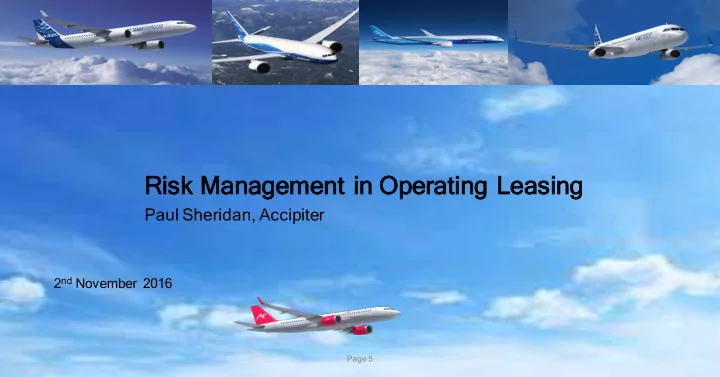

Risk Management in Operating Leasing Ri Paul Sheridan, Accipiter 2 nd November 2016 Page 5
Accipiter: A Growth Focused Lessor 43 Aircraft ~$1.9bn assets 89% Narrowbody Fleet (by CMV) Wholly owned subsidiary of CK Hutchison Holdings Shareholder 27 employees with 200+ Expertise Committed Growth Capital Limited (Reuters Code years experience in Aviation 0001.HK) Diversified Global Customer 21 Airlines, 14 Countries Average Age 4 years Base Average Remaining Lease Aircraft Manufacturers Airbus (51%)/Boeing (49%) 6 years Term Page 6 Page 6
Presentation overview Risk management framework Asset Structure Credit Structuring deals within the framework Portfolio management Page 7 Page 7
Risk management priorities Do I understand the Asset future value of the asset? Understanding the Can I get it back as interaction between Structure quickly and efficiently as these three areas leads possible? to better deal decisions What are the chances of Credit me having to do this? Page 8 Page 8
Asset risk Best value retention with lowest volatility Focus on purchase price Core to lessor core to lessee Remarketable specification Page 9 Page 9
Valuation depends on perspective Airline Lessor What routes can the aircraft fly? What rents will I get for the aircraft? How much will it cost to fly it? What risk am I taking on finding a new lessee? • Direct costs Can I trade it on? • Ownership costs However, if the airline wants to fly the aircraft the lessor will want to buy it Page 10
Easy to forget in today’s market: Aircraft values depreciate and are cyclical Source: Ascend Source: Ascend Aircraft historical value index Source: Ascend Page 11 Page 11
What do lessors want to invest in? High MV volatility 737 – 300 MD – 80 767 – 300ER CRJ200 A380 – 800 747 – 400 777 – 200LR A320 – 200 A330 – 200 737 – 800 777 – 200LRF 787-9 A330 – 200 717 – 200 Low MV volatility Hi BV depreciation Low BV depreciation Source: Ascend Page 12 Page 12
A320-200 value retention Source: Ascend Page 13 Page 13
737-300 value retention Source: Ascend Page 14 Page 14
Key drivers of aircraft values Macro-economic Point in economic cycle , oil / fuel price, inflation, global trade and tourism Supply of aircraft (duopoly manufactures), demand for aircraft (stored Industry aircraft fleet size, airline profitability and regulatory changes), lead time for production of aircraft Position in the production cycle, number of units produced, geographical Aircraft type fleet distribution, number of airline operators, engine choice, product support provided by manufacturer Age , weight, engine thrust, interior configuration, physical and maintenance Aircraft specific condition and hours and cycles Page 15 Page 15
The best aircraft types show value recovery 45.0 Second Gulf Global war/SARS financial crisis outbreak 40.0 35.0 Constant age market value (US$m) 30.0 25.0 25+ year useful life 20.0 V alues oscillate around economic cycles Long term value trend is predictable through the cycle 15.0 Key asset management philosophy is not to dispose of assets at the trough of the cycle 10.0 Not all aircraft types are equal –some types experience more valuevolatility 5.0 than others 0.0 2000 2001 2002 2003 2004 2005 2006 2007 2008 2009 2010 2011 2012 2013 737 – 800 new A320 – 200 5yr A320 – 200 new 737 – 800 5yr Source: Ascend Page 16
Structure risk Repossession risk Country risk analysis Cape Town protections Good lease protections Deregistration Reserves and security deposit Low risk financing No restrictions/permissions on repossession and remarketing Page 17 Page 17
Credit risk Ability to pay rents Strong franchise and solid business plan Lease terms reflect credit quality Ability to maintain and redeliver the aircraft Page 18 Page 18
Airline credit analysis Qualitative analysis Quantitative analysis • Business model • Free cashflow • Franchise in market • Adjusted debt/EBITDAR • Position at hub airports • Adjusted debt/Equity • Management team • RASK/CASK • Access to finance • Cash balance • Profitability record • Profit margins Page 19 Page 19
Combine asset and credit risk in deal decisions When should you do: Shorter lease terms? Non core assets? Widebody aircraft? Leases without reserves? Does the deal add to the portfolio? Top tier credit Region of the world with under-exposure Modern technology asset Page 20 Page 20
Portfolio management – concentration limits Usually measured by: Geography Aircraft class Lease return date Individual name Credit quality All portfolio metrics should be calculated by number of aircraft and by total book value Page 21 Page 21
Typical concentration limits - geography Region % of portfolio Asia Pacific <40% Europe <40% North America <35% South and Central America <25% Middle East <20% Africa <15% Historically, apart from 2008, regions of the world have shown relatively weak correlations for airline profitability Page 22 Page 22
Typical concentration limits – lease return Key to ensuring stability of earnings Monitor lease return dates Fleet by lease return date 20.0% regularly 18.0% 16.0% 14.0% Limit returns in any year to 20% % of the fleet redelivering 12.0% of portfolio 10.0% 8.0% Having sister ships with 6.0% 4.0% reasonably close redelivery 2.0% 0.0% dates can be an advantage 2017 2018 2019 2020 2021 2022 2023 2024 2025 2028 A320-200 A321-200 A330-300 B737-700 B737-800 B737-900ER B777-300ER Monitor competitor aircraft for less liquid types Page 23 Page 23
Other portfolio metrics Average age Remaining lease term Single name concentrations Narrowbody/widebody mix Credit tier Core/non core aircraft Metrics depend on investor strategy as much as risk management policy Page 24 Page 24
Questions? Qu Page 25
Recommend
More recommend